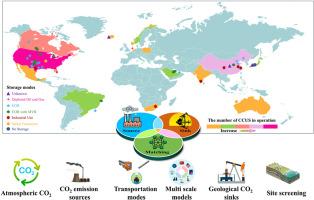CCUS源汇匹配研究进展与展望
IF 16.3
1区 工程技术
Q1 ENERGY & FUELS
引用次数: 0
摘要
碳捕集、利用与封存(CCUS)作为一项重要的减排技术,其关键依赖于源汇匹配。这一基本要素发挥着至关重要的作用,它将二氧化碳排放点(源)与适当的地质储存点(汇)高效、经济地连接起来。这种匹配对于实现CCUS在广泛部署和环境效益方面的潜力是必不可少的。虽然匹配技术框架相对成熟,但专门针对源汇匹配的全面研究仍然有限。本文系统综述了CCUS源汇匹配研究进展,围绕“源汇匹配”的三个核心维度,综合了全球CO2排放源时空分布格局、地质容量评估、潜在分布、源汇连接运输方式等关键要素。通过深入分析,本文确定了四大系统性挑战:技术-经济-政策体系的脱节;源和汇之间数据精度和尺度的差异;运输优化方法不灵活,集群协作不足;算法-物理机制脱节缺乏动态演化表征。在对当前挑战和发展进行全面考察的基础上,本研究提出了加强CCUS源汇匹配框架的战略建议。这些建议旨在加速全球CCUS部署规划,推进国际碳中和目标。本文章由计算机程序翻译,如有差异,请以英文原文为准。

Progress and perspectives in source-sink matching for CCUS: A critical review
As an essential technology for significant emission reductions, carbon capture, utilization, and storage (CCUS) rely critically on source-sink matching. This fundamental element plays a vital role by connecting CO2 emission points (sources) to appropriate geological storage sites (sinks) efficiently and cost-effectively. Such matching is indispensable for realizing CCUS's potential in widespread deployment and environmental benefits. Although the matching technology framework is relatively mature, comprehensive reviews specifically addressing source-sink matching remain limited. This paper systematically reviews the current advancements in CCUS source-sink matching research, focusing on the three core dimensions of “source-sink-matching,” and synthesizes key elements, including the spatiotemporal distribution patterns of global CO2 emission sources, geological capacity assessment, and potential distribution, as well as transportation modes connecting sources and sinks. Through in-depth analysis, this paper identifies four systemic challenges: disconnects in technology-economy-policy systems; discrepancies in data accuracy and scale between sources and sinks; inflexible transport optimization methods and insufficient cluster collaboration; and algorithm-physical mechanism disconnections lacking dynamic evolution characterization. Building on a thorough examination of current challenges and developments, this study proposes strategic recommendations for enhancing CCUS source-sink matching frameworks. These recommendations aim to accelerate global CCUS deployment planning and advance international carbon neutrality goals.
求助全文
通过发布文献求助,成功后即可免费获取论文全文。
去求助
来源期刊

Renewable and Sustainable Energy Reviews
工程技术-能源与燃料
CiteScore
31.20
自引率
5.70%
发文量
1055
审稿时长
62 days
期刊介绍:
The mission of Renewable and Sustainable Energy Reviews is to disseminate the most compelling and pertinent critical insights in renewable and sustainable energy, fostering collaboration among the research community, private sector, and policy and decision makers. The journal aims to exchange challenges, solutions, innovative concepts, and technologies, contributing to sustainable development, the transition to a low-carbon future, and the attainment of emissions targets outlined by the United Nations Framework Convention on Climate Change.
Renewable and Sustainable Energy Reviews publishes a diverse range of content, including review papers, original research, case studies, and analyses of new technologies, all featuring a substantial review component such as critique, comparison, or analysis. Introducing a distinctive paper type, Expert Insights, the journal presents commissioned mini-reviews authored by field leaders, addressing topics of significant interest. Case studies undergo consideration only if they showcase the work's applicability to other regions or contribute valuable insights to the broader field of renewable and sustainable energy. Notably, a bibliographic or literature review lacking critical analysis is deemed unsuitable for publication.
 求助内容:
求助内容: 应助结果提醒方式:
应助结果提醒方式:


